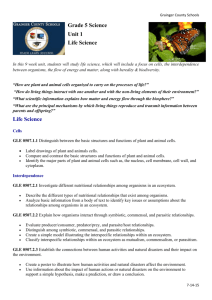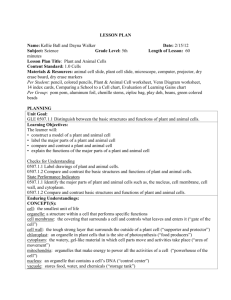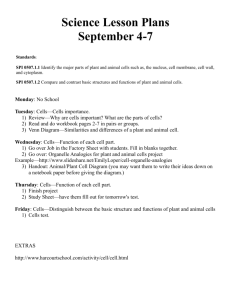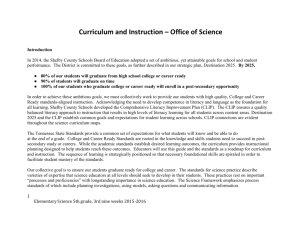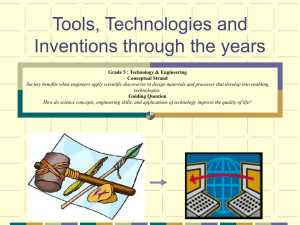Discover the Waters of Tennessee 5
advertisement
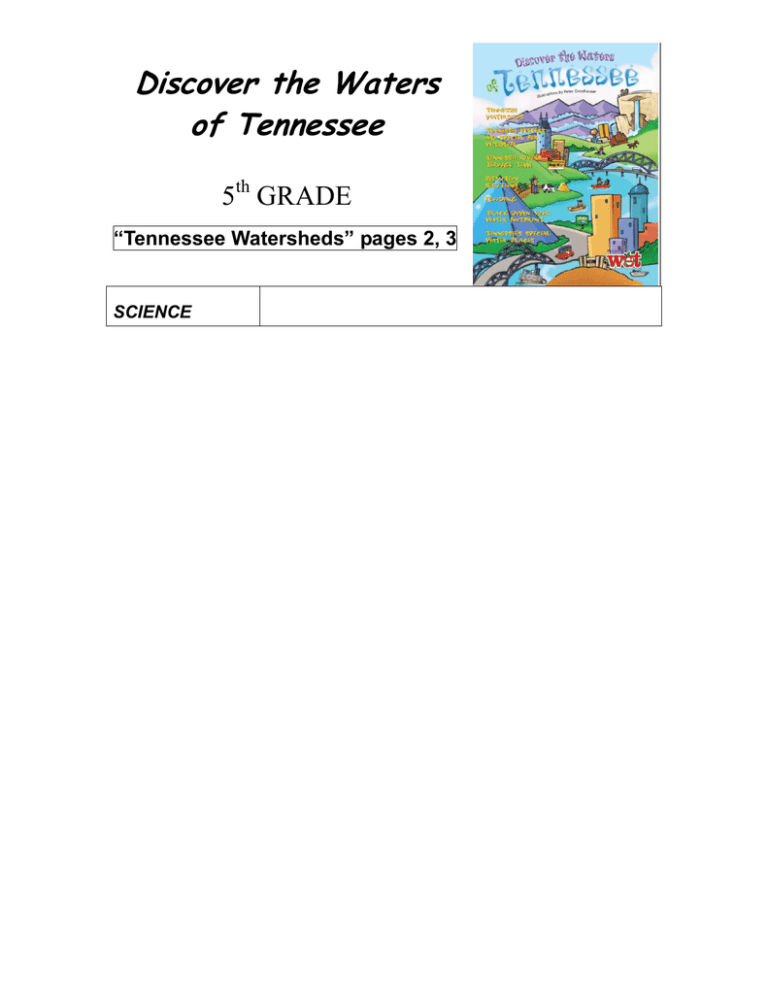
Discover the Waters of Tennessee 5th GRADE “Tennessee Watersheds” pages 2, 3 SCIENCE Embedded Inquiry GLE 0507.Inq.1 Explore different scientific phenomena by asking questions, making logical predictions, planning investigations, and recording data “Tennessee Waters are Special for Wildlife” pages 4, 5 SCIENCE Embedded Inquiry GLE 0507.Inq.1 Explore different scientific phenomena by asking questions, making logical predictions, planning investigations, and recording data Life Science Interdependence GLE 0507.2.1 Investigate different nutritional relationships among organisms in an ecosystem GLE 0507.2.2 Explain how organisms interact through symbiotic, commensal, and parasitic 0507.2.1 Evaluate producer/consumer, predator/prey, and parasite/host relationships 0507.2.2 Classify interspecific relationships within an ecosystem as mutualism, commensalism, or parasitism 0507.2.3 Create a simple model illustrating the interspecific relationships within an ecosystem SPI 0507.2.1 Describe the different types of nutritional relationships that exist among organisms Life Science – Biodiversity and Change GLE 0507.5.1 Investigate physical characteristics associated with different groups of animals 0507.5.2 Design a model to illustrate how an animal’s physical characteristics enable it to survive in a particular environment SPI 0507.5.1 Identify physical and behavioral adaptations that enable animals such as, amphibians, reptiles, birds, fish, and animals to survive in a particular environment “Tennessee Rivers through Time” pages 6, 7 SCIENCE Life Science Interdependence GLE 0507.2.2 Explain how organisms interact through symbiotic, commensal, and parasitic SPI 0507.2.3 Use information about the impact of human actions or natural disasters on the environment to support a simple hypothesis, make a prediction, or draw a conclusion Life Science – Biodiversity and Change GLE 0507.5.2 Analyze fossils to demonstrate the connection between organisms and environments that existed in the past and those that currently exist 0507.5.3 Identify the processes associated with fossil formation 0507.5.4 Use fossil evidence to describe an environment from the past 0507.5.5 Use fossils to match a previously existing organism with one that exists today “Pollution Solution” pages 8, 9 SCIENCE Embedded Inquiry GLE 0507.Inq.1 Explore different scientific phenomena by asking questions, making logical predictions, planning investigations, and recording data “Flooding” pages 10, 11 SCIENCE Embedded Inquiry GLE 0507.Inq.4.Identify and interpret simple patterns of evidence to communicate the findings of multiple investigations 0507.Inq.4 Analyze and communicate findings from multiple investigations of similar phenomena to reach a conclusion SPI 0507.Inq.1 Select an investigation that could be used to answer a specific question Life Science – Interdependence GLE 0507.2.3 Establish The connections between human activities and natural disasters and their impact on the environment 0507.2.5 Create a poster to illustrate how human activities and natural disasters affect the environment SPI 0507.2.3 Use information about the impact of human actions or natural disasters on the environment to support a simple hypothesis, make a prediction, or draw a conclusion Life Science – Biodiversity and Change GLE 0507.5.2 Analyze fossils to demonstrate the connection between organisms and environments that existed in the past and those that currently exist MATH Strand 19: Tables, Graphs and Charts A. Identify correct information from tables, bar graphs, pictographs, and charts B. Create bar graphs and pictographs from data in tables and charts Strand 20: Statistics and Data Analysis A. Drop reasonable conclusions from data in tables, bar graphs, pictographs, circle graphs and charts B. State a conclusion and explain why a claim is or is not reasonable, based on the data “Track Down Your Water Footprint” pages 12, 13 SCIENCE Embedded Inquiry GLE 0507.Inq.1 Explore different scientific phenomena by asking questions, making logical predictions, planning investigations, and recording data GLE 0507.Inq.3 Organize data into appropriate tables, graphs, drawings or diagrams 0507.Inq.1 Identify specific investigations that could be used to answer a particular question and identify reasons for this choice SPI 0507.Inq.1 Select an investigation that could be used to answer a specific question MATH Strand 19: Tables, Graphs and Charts A. Identify correct information from tables, bar graphs, pictographs, and charts B. Create bar graphs and pictographs from data in tables and charts Strand 20: Statistics and Data Analysis A. Draw reasonable conclusions from data in tables, bar graphs, pictographs, circle graphs and charts B. State a conclusion and explain why a claim is or is not reasonable, based on the data Please: share your feedback and reward your class with a Certificate of Completion!! CONTACT: Cynthia Allen, callen@mtsu.edu, 615-898-2660, WaterWorks! Coordinator MTSU ‘s Center for Environmental Education Special thanks to Bonnie Ervin, Kathy DeWein and Michelle Rogers for their assistance correlating the standards.
